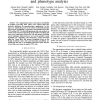Free Online Productivity Tools
i2Speak
i2Symbol
i2OCR
iTex2Img
iWeb2Print
iWeb2Shot
i2Type
iPdf2Split
iPdf2Merge
i2Bopomofo
i2Arabic
i2Style
i2Image
i2PDF
iLatex2Rtf
Sci2ools
BIBE
2007
IEEE
2007
IEEE
The GPU on biomedical image processing for color and phenotype analysis
The computational power and memory bandwidth of graphics processing units (GPUs) have turned them into attractive platforms for general-purpose applications. In this paper, we exploit this power in the context of biomedical image processing by establishing a cooperative environment between the CPU and the GPU. We deal with phenotype and color analysis on a wide variety of microscopic images from studies of cartilage and bone tissue regeneration using stem cells and genetics involving cancer pathology. Both processors are used in parallel to map algorithms for computing color histograms, contour detection using the Canny filter and pattern recognition based on the Hough transform. Task, data and instruction parallelism are exploited in the GPU to accomplish performance gains between 4x and 100x more than the typical CPU code.
BIBE 2007 | Bioinformatics | Biomedical Image Processing | Bone Tissue Regeneration | Graphics Processing Units |
| Added | 12 Aug 2010 |
| Updated | 12 Aug 2010 |
| Type | Conference |
| Year | 2007 |
| Where | BIBE |
| Authors | Antonio Ruiz, Manuel Ujaldon, Jose Antonio Andrades, Jose Becerra, Kun Huang, Tony Pan, Joel H. Saltz |
Comments (0)

